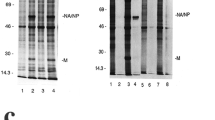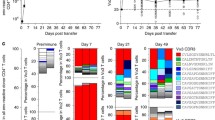Abstract
By priming female C57BL/6 mice with syngeneic male spleen cells and enriching inguinal and paraaortic lymph node cells in long-term culture (LTC) by repeated restimulations, H-Y-specific T helper cells can be produced. In response to male spleen cells carrying I-Ab antigens these cells activate “antigenexpressing” B cells to secrete polyclonal antibody. Before the end of the second week in LTC it was impossible to detect any helper activity. Induction of plaque-forming cells (PFC) also requires simultaneous recognition of antigen and I-A-encoded determinants in the “stimulator-responder” spleen-cell population. The testing of spleen cells fromH-2 recombinant strains as “stimulator-responders” to anti-H-Y helper T cells of C57BL/6 origin also revealed that other genes, telomeric toI-A, control the magnitude of both specific T-cell proliferation and helper-dependent B-cell activation.
Similar content being viewed by others
References
Augustin, A. A. and Coutinho, A.: Specific T helper cells which activate B-cells polyclonally.J. Exp. Med. 151: 587–601, 1980
Baxevanis, C. N., Nagy, Z. A., and Klein, J.: A novel type of T-T cell interaction removes the requirement for I-B region in the H-2 complex.Proc. Natl. Acad. Sci. U.S.A. 78: 3809–3813, 1981
Bailey, D. W. and Hoste, J.: A gene governing the female response to the male antigen in the mice.Transplantation 11: 404–407, 1971
Cammisuli, S., Henry, C., and Wofsy, L.: Role of membrane receptors in the inductions of anin vitro secondary anti-hapten response. I. Differentiation of B memory cells to plasma cells is independent of antigen-immunoglobulin receptor interaction.Eur. J. Immunol. 8: 656–662, 1978a
Cammisuli, S., Henry, C., and Wofsy, L.: Role of membrane receptors in the inductions of anin vitro secondary anti-hapten response. II. Antigen-Immunoglobulin receptor interaction is not required for B memory cell proliferation.Eur. J. Immunol. 8: 662–666, 1978b
Corradini, G., Etlinger, H. M., and Chiller, J. M.: Lymphocyte specificity to protein antigens.J. Immunol. 119: 1048–1053, 1977
Gordon, E. D., Simpson, E., and Samuelson, L. E.:In vitro cell mediated immune responses to the male specific (H-Y) antigen in mice.J. Exp. Med. 142: 1108–1120, 1975
Greene, M. I., Benacerraf, B., and Dorf, M.: The characterization of the delayed-type hypersensitivity reaction to H-Y antigens.Immunogenetics 11: 267–273, 1980
Gronowicz, E., Coutinho, A., and Melchers, F.: A plaque assay for all cells secreting Ig of a given type or class.Eur. J. Immunol. 6: 588–590, 1976
Hurme, M., Hetherington, C. M., Chandler, P. R., and Simpson, E.: Cytotoxic T-cell responses to H-Y; Mapping of the Ir genes.J. Exp. Med. 147: 758–767, 1978
Jones, P., Murphy, B., McDevitt, H.; Two gene control of the expressions of a murine Ia antigen.J. Exp. Med. 148: 925–939, 1978
Klein, J., Juretić, A., Baxevanis, C. N., and Nagy, Z.: The traditional and new version of the mouse H-2 complex.Nature 291: 455–460, 1981
Liew, F. Y. and Simpson, E.: Delayed-type hypersensitivity responses to H-Y: Characterization and mapping of Ir genes.Immunogenetics 11: 255–266, 1980
Martinez, C., Coutinho, A., Bernabe, R., Augustin, A. A., Haas, W., and Pohlit, H.: Hapten specific helper T-cells. I. Collaboration with B-cells to which the bapten has been directly coupled.Eur. J. Immunol. 10: 403–410, 1980a
Martinez, C., Coutinho, A., Bernabe, R., Augustin, A. A., and Haas, W.: Hapten specific helper T-cells. II. Genetic determination of functional recognition.Eur. J. Immunol. 10: 411–416, 1980b
Martinez, C. and Coutinho, A.: B-cell activations by helper cells is a two step process.Nature 290: 60–61, 1981
Tees, R., Nordin, A. A., Schreier, M. H., Bianchi, A. T. J., Hooijkaas, H., and Benner, R.: Clones of helper T cells mediate antigen-specific, H-2 restricted DTH.Nature 290: 62–53, 1981
von Boehmer, H., Fathman, C. G., and Haas, W.: H-2 gene complementation in cytotoxic T cell responses of female against male cells.Eur. J. Immunol. 7: 443–447, 1977
von Boehmer, H., Haas, W., and Jerne, N. K.: MHC linked immune responsiveness is acquired by lymphocytes of low-responder mice differentiating in thymus of high-responder mice.Proc. Natl. Acad. Sci. U.S.A. 75: 2439–2442, 1978
von Boehmer, H. and Haas, W.: Distinct Ir genes for helper and killer cells in the cytotoxic response to H-Y antigen.J. Exp. Med. 150: 1134–1142, 1979
Author information
Authors and Affiliations
Rights and permissions
About this article
Cite this article
Pettersson, S., Pobor, G. & Coutinho, A. MHC restriction of male-antigen-specific T helper cells collaborating in antibody responses. Immunogenetics 15, 129–138 (1982). https://doi.org/10.1007/BF00621946
Received:
Revised:
Issue Date:
DOI: https://doi.org/10.1007/BF00621946




